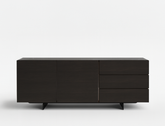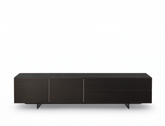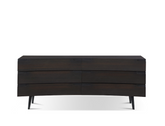Choosing Between a Sofa and Sectional for Small Spaces

Your living room is more than just a space—it's where you gather with family, entertain guests, and unwind after a long day. To make this room as inviting and comfortable as possible, choosing the right furniture is essential. One of the most crucial decisions you'll make is selecting the ideal seating arrangement.
In the heart of your living room, the seating choice serves as the anchor that ties the space together. It sets the tone for your room's style and functionality, offering a place for meals, conversations, and relaxation. But with so many options available, which type of seating is best for your small living room: a traditional sofa or a sectional? Both have their merits, and the right choice depends on your specific needs, preferences, and the space you have available.
In this guide, we'll break down the key differences between sofas and sectionals, exploring their shapes, sizes, and aesthetic appeals, as well as the pros and cons of each option. By the end, you'll have a clear understanding of which piece of furniture will work best in your living room.
Sofa vs. Sectional: Understanding the Key Differences
Shape
The shape of your seating can greatly influence the overall flow and functionality of your living room.
A sofa typically has a straightforward, linear design, accommodating three to four people comfortably. This makes it a versatile choice for small spaces where simplicity and ease of arrangement are priorities. Sofas usually come as a single unit, which can be paired with other furniture pieces, such as armchairs or accent chairs, to create a balanced seating area.
In contrast, a sectional consists of multiple pieces that can be arranged in various configurations to suit your space. One of the most popular configurations for small living rooms is the L-shaped sectional. This design not only maximizes seating but also helps define different areas within the room, such as separating the seating area from the dining or workspaces. The flexibility of a sectional allows you to customize the layout according to your needs, making it a more dynamic choice for those who like to change things up.
Size
When considering size, both sofas and sectionals come in a range of dimensions to fit different spaces. However, the sectional often offers more seating within a compact footprint, making it a popular choice for small living rooms where every square foot counts.
A standard sofa might be a two-seater or a four-seater, depending on your space and needs. It's perfect for small to medium-sized living rooms where you might want to leave room for additional furniture like side tables or a coffee table.
On the other hand, sectionals can extend beyond four seats, making them ideal for larger gatherings or families. There are even compact sectional designs tailored specifically for smaller spaces, providing ample seating without overwhelming the room. These smaller sectionals often include features like chaise lounges or hidden storage, adding to their functionality without taking up extra space.
Aesthetic Appeal
The aesthetic appeal of your seating choice will significantly impact the overall vibe of your living room.
A sofa brings a classic, clean look that works well in formal living rooms or spaces where you want a more traditional feel. Its simplicity allows you to pair it with various other pieces, such as accent chairs or ottomans, creating a cohesive and balanced room design. This flexibility in styling makes the sofa a timeless piece that can easily adapt to changing decor trends.
In contrast, a sectional provides a more casual, inviting atmosphere. Its larger size and unique shape make it the focal point of the room, often dictating the arrangement of other furniture. The sectional's design encourages conversation and interaction, making it perfect for homes where gatherings are frequent. Its cozy, enveloping structure can make a small living room feel warm and welcoming, turning it into a true retreat from the outside world.
If you're leaning towards a cozy, all-in-one seating option that can serve multiple purposes—lounging, conversing, or even napping—a sectional might be your best bet. However, if you prefer a more flexible arrangement with space for additional seating, a sofa could be the right choice for you.
Advantages of Choosing a Sofa
Ideal for Small Spaces
A sofa is a great fit for small living rooms, especially those where space is at a premium. Its compact design allows it to fit comfortably in most rooms, leaving enough space for other essential furniture pieces.
Versatile Pairing
One of the biggest advantages of a sofa is its ability to pair with other seating options. Whether you want to add a couple of armchairs, a loveseat, or even an accent chair, a sofa gives you the freedom to mix and match without overcrowding the room.
Cost-Effective
In general, sofas are less expensive than sectionals. This makes them a budget-friendly option for those looking to furnish a small living room without breaking the bank. Additionally, since sofas are often sold as standalone pieces, you can start with the basics and gradually add to your seating arrangement as needed.
Simple Aesthetic
Sofas offer a clean, minimalist aesthetic that’s easy to work with. Whether your style is modern, traditional, or somewhere in between, a sofa can seamlessly integrate into your decor. This simplicity makes it a practical choice for homeowners who like to update their decor regularly.
Disadvantages of a Sofa
Limited Seating
While a sofa can comfortably seat three to four people, it doesn’t offer the same seating capacity as a sectional. This limitation might be an issue if you frequently host gatherings or have a large family.
Additional Costs for Extra Seating
If you find that you need more seating, you’ll need to purchase additional chairs or loveseats, which can add to the overall cost of furnishing your living room.
Advantages of Choosing a Sectional
Increased Seating Capacity
A sectional provides more seating than a traditional sofa, making it ideal for larger families or those who entertain often. Its expansive design can accommodate multiple people, allowing everyone to gather comfortably in one area.
Conversation-Friendly Layout
The L-shaped design of many sectionals encourages conversation, making it easy for everyone to interact without having to turn their heads or rearrange seats. This makes sectionals a great choice for social households where interaction is a priority.
Built-In Storage Options
Many sectionals come with built-in storage, a feature that’s particularly useful in small living rooms. This discreet storage can be used to keep blankets, pillows, or other items out of sight, helping to maintain a clutter-free space.
Customizable Configurations
Sectionals often allow for customization in terms of configuration. Whether you need a left-facing, right-facing, or even a U-shaped sectional, you can find a design that perfectly fits your space and needs. This adaptability makes sectionals a versatile option for various room layouts.
Disadvantages of a Sectional
Bulkiness
The bulkiness of a sectional can be a downside, especially in very small living rooms. Moving or rearranging a sectional can be cumbersome, and its size might dominate the room, leaving little space for other furniture.
Higher Cost
Sectionals are generally more expensive than sofas, particularly those with additional features like storage or reclining seats. This higher cost can be a drawback for those on a tight budget.
Making the Right Choice
When deciding between a sofa and a sectional, it’s essential to consider the size of your living room, your seating needs, and your personal design preferences.
For small living rooms, a sofa is often the go-to choice because of its versatility and ability to fit into tight spaces. It allows for more flexibility in arranging other furniture and can be easily complemented with additional seating when needed.
However, if your small space can accommodate it and you require more seating, a sectional might be the better option. Its ability to maximize seating in a small area, coupled with the option for built-in storage, makes it a practical choice for many households. Just be mindful of its size relative to your room to avoid overwhelming the space.
In terms of design, consider how you plan to style your living room. If you enjoy having a variety of furniture pieces and want a more open, flexible layout, a sofa is likely the better fit. On the other hand, if you prefer a cozy, all-in-one seating area that serves as the focal point of the room, a sectional could be the ideal choice.
FAQs
1. Can I fit a sectional in a small living room? Yes, you can fit a sectional in a small living room, especially if you choose a compact design like an L-shaped sectional. However, it's important to measure your space carefully to ensure the sectional doesn't overwhelm the room.
2. Are sofas less expensive than sectionals? Generally, sofas are less expensive than sectionals, making them a budget-friendly option for small living rooms. The cost can vary depending on the size, material, and brand.
3. What are the advantages of a sectional over a sofa? A sectional offers more seating space, a conversation-friendly layout, and often includes built-in storage. It's also customizable in configuration, allowing you to tailor it to your specific room layout.
4. Can I rearrange a sectional easily? Rearranging a sectional can be more challenging than moving a sofa due to its bulk and multiple pieces. However, some sectionals are designed with modular components that can be rearranged more easily.
5. How do I choose between a sofa and a sectional? Consider your living room size, seating needs, and design preferences. If space is limited and you prefer a versatile layout, a sofa may be best. If you need more seating and want a cozy, all-in-one piece, a sectional could be the better choice.
6. Is a sectional suitable for formal living rooms? While sectionals are often associated with casual, cozy spaces, they can also be styled to fit formal living rooms, especially with the right fabric and configuration choices.
Conclusion
Ultimately, the choice between a sofa and a sectional for your small living room depends on your space, needs, and design goals. Both options have their strengths, so consider what matters most to you—whether it's maximizing seating, creating a flexible layout, or achieving a particular aesthetic. By weighing the pros and cons of each, you'll be well-equipped to make a decision that enhances both the comfort and style of your living room.
Spruce up your living room with a stylish modern sofa and sectional furniture pieces from Prestige Affairs! Browse through our extensive collection of 2-seater, 3-seater, and 4-seater sofas and L-shaped sectionals for the best prices in Singapore.
- 2 Seater Sofa
- 3 Seater Sofa
- Accent Chairs
- Chaise Lounge
- Coffee Tables
- Contemporary Sofa
- Customised Sofa
- Fabric Sofa
- High Back Sofa
- High-end Fabric Sofa
- L-Shape Sofa
- Leather Sofa
- Living Room
- Loveseat
- Mid-Century Sofa
- Modular Sofa
- Sectional Sofa
- Side Table
- Sofa Singapore
- Storage Furniture
- Velvet Sofa
- Water Repellent Sofa







